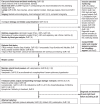The Diagnosis and Treatment of Postoperative Right Heart Failure
- PMID: 35583115
- PMCID: PMC9669324
- DOI: 10.3238/arztebl.m2022.0207
The Diagnosis and Treatment of Postoperative Right Heart Failure
Abstract
Background: Acute right heart failure is a life-threatening condition that can arise postoperatively. The options for symptomatic treatment have been markedly expanded in recent years through the introduction of percutaneously implantable mechanical cardiac support systems.
Methods: This review is based on publications retrieved by a selective literature search in PubMed as well as on guidelines from Germany and abroad.
Results: The diagnostic evaluation of right heart failure is chiefly based on echocardiography and pulmonary arterial catheteri - zation and is intended to lead to immediate treatment. Alongside treatment of the cause of the condition, supportive management is crucial to patient survival. A variety of ventilation strategies depending on the situation, catecholamine therapies, inhaled selective pulmonary vasodilators, and cardiac support systems are available for this purpose. The in-hospital mortality of postoperative right heart failure is 5-17 %. The results of the use of cardiac support systems reported in case series are dis - appointing, but nonetheless good compared to what these critically ill patients would face without such treatment. In one observational study, the 30-day survival rate was 73.3%.
Conclusion: Survival is aided by the rapid recognition of right heart failure, targeted multidisciplinary treatment, and contact with an extracorporeal life support (ECLS) center for additional supportive treatment measures. Further studies on the use of pharmacological and mechanical cardiac support systems must be carried out to provide stronger evidence on which treatment recommendations can be based.
Figures




Comment in
-
Oxygen Therapy in Right Heart Failure.Dtsch Arztebl Int. 2023 Mar 17;120(11):191. doi: 10.3238/arztebl.m2022.0374. Dtsch Arztebl Int. 2023. PMID: 37222035 Free PMC article. No abstract available.
References
-
- Adeleke I, Blitz J. Perioperative frailty: lessons learned and future directions. Curr Opin Anaesthesiol. 2021;34:373–380. - PubMed
-
- Schafer B, Greim CA. [Acute perioperative right heart insufficiency: diagnostics and treatment] Anaesthesist. 2018;67:61–78. - PubMed
-
- Harjola VP, Mebazaa A, Celutkiene J, et al. Contemporary management of acute right ventricular failure: a statement from the Heart Failure Association and the Working Group on Pulmonary Circulation and Right Ventricular Function of the European Society of Cardiology. Eur J Heart Fail. 2016;18:226–241. - PubMed
-
- McDonagh TA, Metra M, Adamo M, et al. 2021 ESC guidelines for the diagnosis and treatment of acute and chronic heart failure. Eur Heart J. 2021;42:3599–3726. - PubMed
-
- Truby L, Mundy L, Kalesan B, et al. Contemporary outcomes of venoarterial extracorporeal membrane oxygenation for refractory cardiogenic shock at a large tertiary care center. ASAIO J. 2015;61:403–409. - PubMed
Publication types
MeSH terms
Substances
LinkOut - more resources
Full Text Sources
Medical

